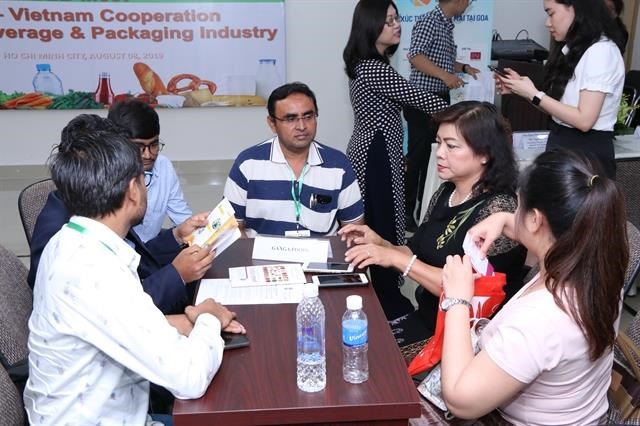 |
|
Indian and Vietnamese firms in the food, beverages and packaging sector exchange information at a B2B meeting in HCM City last week |
Ly KimChi, Chairwoman of the Food and Foodstuff Association of Ho Chi Minh City, saidthe food and beverage sector accounts for 15 percent of Vietnam’s GDP andis growing at 7 percent annually on average.
“Vietnamesespend a third of their income on food and beverages,” she told a B2B event heldin HCM City last week that attracted the participation of 49 Indian companieswho exhibited their products at the recent Vietfood and Beverage-Propackexhibition.
Indian ConsulGeneral in HCM City, Dr. K Srikar Reddy, said Vietnam is a major producer andexporter of food and agricultural products but “is also a major food importerand consumer.
“Agriculturalproducts form a significant portion of the total bilateral trade between thetwo countries. India is among major suppliers to Vietnam of food products likeseafood, meat, cereals, and fresh and processed vegetables and fruits.”
MohanRamesh Anand, chairman of the Indian Business Chamber in Vietnam, said with apopulation of over 95 million and increasing demand for food and beverages, Vietnamis a large food and beverage market, making it attractive to local andinternational investors, including Indian.
Hebelieved Indian investment in Vietnam would increase in future.
Manyleading Polish businesses that produce beef, poultry and pork meat, meat-basedproducts, fresh and frozen fruits and vegetables, fruit concentrates andpreserves, and other food products are looking to enter the Vietnamese market.
Speakingto the media on the sidelines of the Vietnam-Poland B2B meeting in the foodsector in HCM City last week, Piotz Ziemann, Vice President of the Associationof Butchers and Producers of Processed Meat of the Republic of Poland, said hiscountry’s advantage is that it produces beef at 17 percent less cost than therest of the EU but tops them in quality.
Of itsbeef production 85 percent is meant for export, and it is 55 percent forchicken and 47 percent for pork, he said.
“Poland’sfoods not only have high quality, but also are safe and tasty.
“Withfast economic growth and improving living standards, Vietnamese tend to choosefood products that have higher quality, safer and tastier. This offers goodopportunities for Poland companies in the sector.”
Poland’spork has appeared in the Vietnamese market, but beef and chicken are still newto Vietnam though they are popular in fastidious markets such as the Republic ofKorea and Japan, he said.
He hopedthe new EU programme titled “Tasteful Europe - Tradition and Quality” that wasrecently launched in Vietnam and will be carried out from 2019 to 2022 wouldyield positive results, with more Vietnamese customers knowing about and usingPolish meat products and fruits and vegetables.
Theprogramme seeks to promote products like fresh, chilled and frozen meats, meatproducts, and high-quality poultry and fresh and processed fruit and vegetablesin Vietnam and other Asian markets.
It wouldprovide Vietnamese consumers with knowledge about the uniqueness of Europeanfood production and convince the unconvinced that values such as productionsafety at every stage from field to table, and the resulting quality,sustainability and flavour combined with tradition would bring about a uniqueculinary experience, Ziemann said, who is also the head of the project.
The EU-VietnamFree Trade Agreement (EVFTA) would offer opportunities to enhance investmentand trade ties between Vietnam and Poland, he added.-VNS/VNA
 Vietnam has become an increasingly attractive destination for international enterprises in the food, beverages and packaging industry thanks to its rapid economic growth and rising consumer demand.
Vietnam has become an increasingly attractive destination for international enterprises in the food, beverages and packaging industry thanks to its rapid economic growth and rising consumer demand.